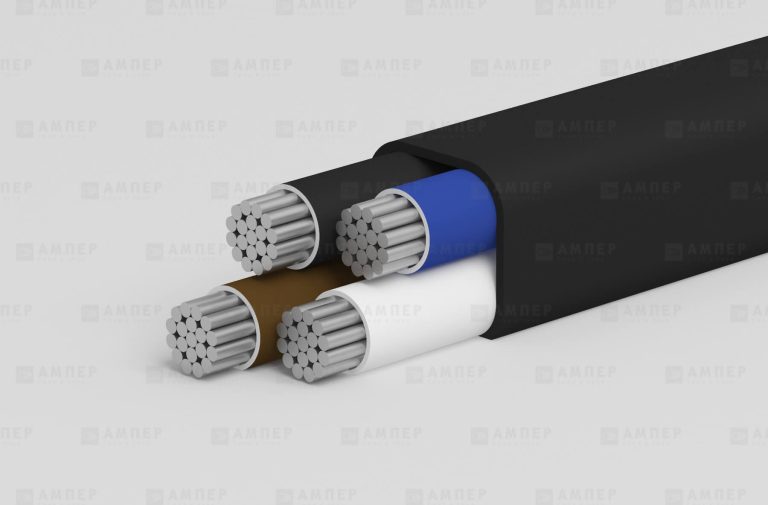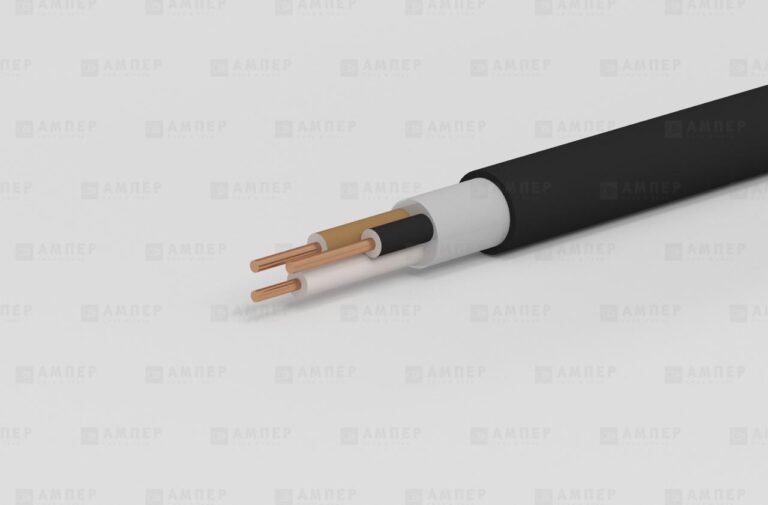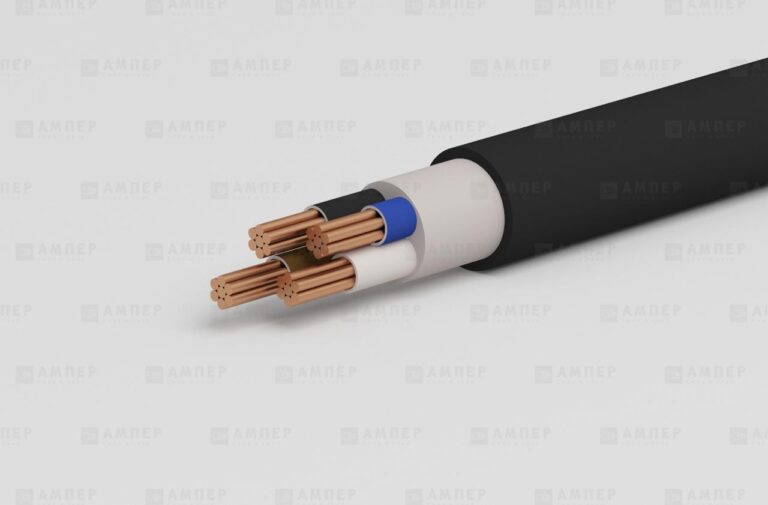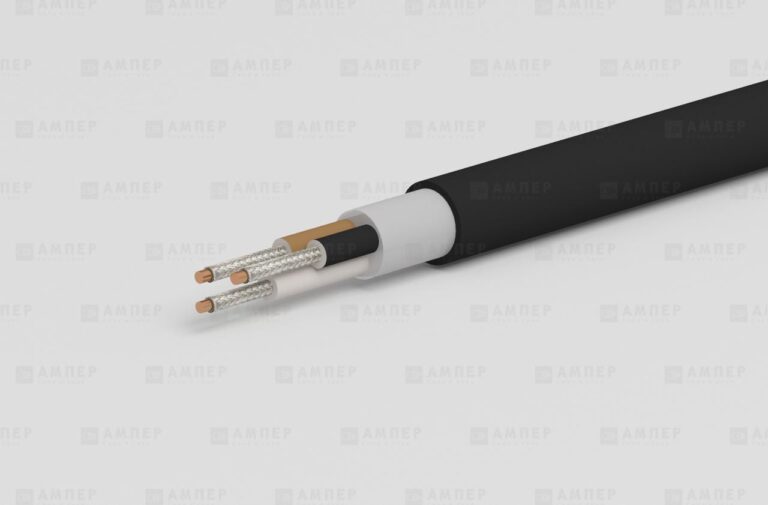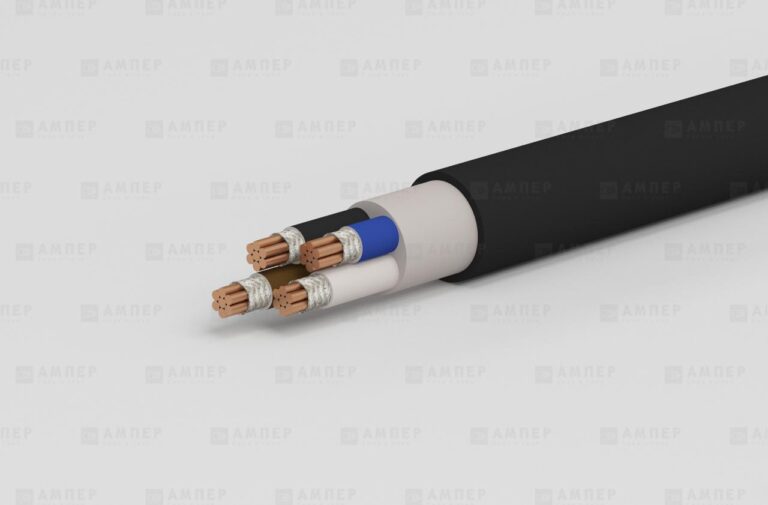Power cables with plastic insulation GOST 16442-80
Cables are designed for transmission and distribution of electrical energy in stationary installations for rated alternating voltage 0.66 and 1 kV, frequency 50 Hz. Types of climatic performance: NF, T placement categories 1, 5 according to GOST 15150-69, as well as when laying in the soil.
Ambient temperature during operation in a stationary state: from -50˚C to + 50˚C, relative air humidity 98% at a temperature of 35˚C, including for laying in the open air.
Minimum bending radius of the cable during laying:
– Single-core cables: 10D, where D is the outer diameter of the cable, mm.
– Multicore cables: 7.5D, where D is the outer diameter of the cable, mm.
Long-term permissible heating temperature of cable conductors during operation: 70 ˚С.
Cables can be used in DC voltage networks, with voltage values 2.4 times higher than Uₒ (where Uₒ is the voltage between the core and the screen).
Warranty period of operation: 5 years.
Cable construction
– The design of the electrical conductor of I and II classes in accordance with GOST 22483-2012.
– Insulation of current-carrying conductors made of PVC- compound grades I40-13, I40-13A in accordance with GOST 5960-72.
– The casing is made of PVC-compound grade O-40 in accordance with GOST 5960-72.
Power cables with plastic insulation TU 27.32.13-001-51465330-2021 (GOST 31996)
Power cables with copper and aluminium conductors, with plastic insulation, in a plastic cladding, hereinafter referred to as “cables”, intended for the transmission and distribution of electricity in stationary installations with a rated alternating voltage of 0.66; 1 and 3 kV with a nominal frequency of 50 Hz. The cables comply with GOST 31996. GOST 31996 meets international standard IEC 60502-1:2004.
The cables are intended for the needs of the national economy and are used at industrial and energy facilities. Cables in the “ng(A)-LS” design can be used at nuclear power plants outside the containment area in AC systems of classes 2, 3 and 4 according to the OPB 88/97 classifier (PNAE G-01-011) and at metro facilities.
Cables that do not spread flame when installed in groups can be used in explosive zones of classes 0, 1 and 2 according to GOST 30852.13-2002 (IEC 60079-14:1996).
The cables are seismically resistant to earthquakes with an intensity of 9 points according to MSK – 64 at an installation level above the zero mark of up to 35 m, seismic safety group 2 according to GOST 30546.1
Type of climatic modification UHL, placement categories 1 – 5 according to GOST 15150.
Warranty period: 5 years.
The cables are designed for use in alternating voltage electrical networks with a grounded or insulated neutral. The duration of operation in networks with an isolated neutral in the mode of a single-phase short circuit to earth does not exceed 8 hours, and the total duration of operation in the mode of a single-phase short circuit to earth does not exceed 125 hours in 12 months.
The maximum network voltage at which cables can be operated Um is 1.2U.
The cables are allowed to be used in direct current electrical networks at voltage values 2.4 times higher than Uо (where Uо is the rated voltage between the core and the screen, kV).
Cables can be laid without limiting the difference in levels along the laying route, including in vertical sections.
All cables, except for cold-resistant cables with an outer sheath or protective hose made of polyvinyl chloride plastic or a halogen-free polymer composition, can be laid without preheating at a temperature not lower than minus 15 ° C.
Cold-resistant cables with an outer sheath or protective hose made of polyvinyl chloride plastic or a halogen-free polymer composition can be laid without preheating at a temperature not lower than minus 30 °C.
Cables with cross-linked polyethylene insulation or cables with a protective polyethylene hose can be laid without preheating at a temperature not lower than minus 20 °C.
The minimum bending radius during installation must correspond to that indicated in table 1.
Table 1 – Minimum bending radius of cables during installation
Power cables | Minimum bending radius, mm |
single-core | 10 Dн |
multi-core | 7,5 Dн |
The cables are intended for operation in a stationary state at ambient temperatures from minus 50 °C to plus 50 °C (except for cables in a cold-resistant design or cables with a protective polyethylene hose) and a relative air humidity of 98% at a temperature of 35 °C, including for installation on open air. Cold-resistant cables or cables with a protective polyethylene hose are designed for operation at ambient temperatures from minus 60 °C to plus 50 °C.
It is allowed to use flame retardant cables in hazardous areas in accordance with the established requirements of GOST R 51330.13:
– armored, flame retardant – open and hidden laying for classes 0, 1, 2;
– unarmored – open and hidden method for classes 0, 1, 2 in steel water and gas pipes with a single installation method and open method for class 2 in the absence of mechanical and chemical influences.
The permissible heating temperatures of the current-carrying cable cores during operation should not exceed those indicated in Table 2.
Table 2 – Permissible heating temperatures of current-carrying cable cores
|
Cable insulation material
|
Permissible heating temperature of cable cores, оС |
|||
|
long-term permissible |
in overload mode |
short circuit limit |
according to the condition of non-ignition in case of short circuit |
|
|
Polyvinyl chloride plastic compound, polyvinyl chloride plastic compound of reduced fire hazard |
70 |
90 |
160/140* |
350 |
|
Cross-linked polyethylene |
90 |
130 |
250 |
400 |
|
*- for cables with conductive cores with a cross-section of more than 300 mm2. |
||||
Cable designs:
– The conductive cores of the cables must comply with classes 1 or 2 according to GOST 22483.
– Thermal barrier over the conductor for fire-resistant cable in the “FR” version.
– Insulation of current-carrying conductors: polyvinyl chloride plastic; polyvinyl chloride plastic compound of reduced fire hazard; cross-linked polyethylene; polymer composition that does not contain halogens.
– Inner cable cladding: polyvinyl chloride plastic; polyvinyl chloride plastic compound of reduced fire hazard; polymer composition that does not contain halogens.
– Screen: copper tape.
– Armor type: made of two galvanized steel strips or aluminium or aluminium alloy strips, or galvanized steel wires, aluminium or aluminium alloy wires.
– Outer sheath or protective hose (in armored cables): polyvinyl chloride plastic; polyvinyl chloride plastic compound of reduced flammability; polyvinyl chloride plastic compound of reduced fire hazard; polyethylene; polymer composition that does not contain halogens.

